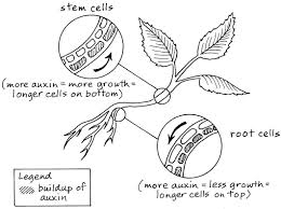plant responses
Just as we respond to our environment, plants do too. In this topic we will study the way in which plants respond to stimuli in their surroundings in order to increase their chances of survival.
|
Plants respond to 3 main stimuli:
The responses of plant roots and shoots to light, gravity and water are known as tropisms. When a plant grows towards a stimulus, the tropism is positive When a plant grows away from a stimulus, the tropism is negative |
|
|
STIMULUS
Light Gravity Water |
NAME OF TROPISM
Phototropism Gravitropism/ geotropism Hydrotropism |
RESPONSE OF PLANT
Shoots grow towards the light (positive phototropism) Roots grow away from light (negative phototropism) Shoots grow away from gravity (negative geotropism) Roots grow towards gravity (positive geotropism) Roots grow towards water |
HOW TROPISM CONTRIBUTES TO SURVIVAL
Light is necessary for photosynthesis Shoots are growing towards the light - see above Roots grow down to anchor the plant in the soil, and also this is where water is likely to be Water is essential for survival of the plant |
HYDROTROPISM IS DOMINANT OVER GEOTROPISM. Plants will grow towards water even if it means growing upwards
|
|
|
Auxins
Auxins are plant hormones and they are responsible for causing the responses of plants to light and gravity (it is still unclear how plants respond to water!). The response of the plant is the result of an uneven distribution of auxin in the growing shoot or root. This causes an unequal growth rate, and as a result the shoot or root bends.
Uses of plant hormones
Auxin isn't the only plant hormone. There are a number of others, including gibberellins, ethene and abscisic acid. Plant hormones are incredibly useful, both in the garden (horticulture) and on commercial farms which provide food (agriculture).
We can use plant hormones to help plants grow and also to get rid of plants that we don't want.
We can use plant hormones to help plants grow and also to get rid of plants that we don't want.





